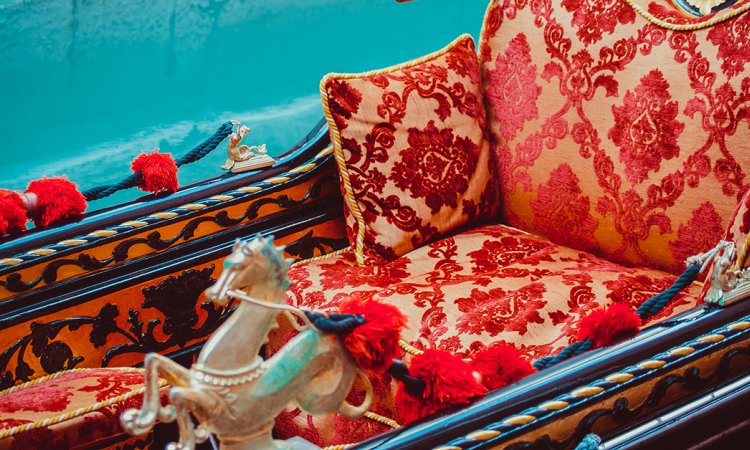
Back when Michelangelo was painting the Sistine Chapel, Galileo was discovering the moons of Jupiter and Leonardo da Vinci was dreaming of the future, kings and queens all over Europe fell in love with the soft, luscious and very expensive velvet produced in Venice.
Venetian velvet was the perfect fabric to show off their power and wealth. Its deep, rich colours were difficult to produce, and therefore even more precious — everyone knew how much you paid for it. Kings lined their crowns with it, insisted their kingly robes be woven from it, and upholstered their thrones with it.
So how did this thriving trade end up with only one factory and only a handful of weavers who can still practice the old method?
A history in velvet
The concept of velvet has been around since about 2000 BCE in Egypt, where the method of pile weaves using silk and linen was first conceived. A version that resembles what we consider velvet today was produced in China between 400 BCE and 23 CE. The weaving techniques then continued to evolve in Turkey, Greece and Cyprus. Velvet production only came to Italy and Spain in the late medieval and early renaissance, when loom technology advanced enough to lower the cost and allow design innovation.
The earliest centers of velvet production in Italy were Lucca, Genoa and Florence. Though Venice had been importing silk from the east for a while (even before Marco Polo), it wasn’t until the 1300s when 300 refugees from Lucca, many of them weavers, brought the art of velvet making to Venice. Named the Lucchesi, these asylum-seekers established the Republic of Venice Velvet Weavers in 1347, an important event in Venetian history.
A velvet renaissance
In the 1400s Venice brought velvet weaving to new heights of sophistication with the soprarizzo method. A double pile technique, it involves weaving one layer of fabric that absorbs light with a lighter layer on top that reflects it. This produced a moving, wave-like effect as you stroke it. Weavers then started making the fabric even more luxurious, adding precious metals and gilded backgrounds to the fabric.
The techniques for making velvet were so important, the weavers and their fellow artisans in the glass and jewelry trade were not allowed to leave Venice for fear their secrets would be divulged. To keep their secret technique to themselves Venetians invented patent law in 1474.
Venetian velvet was all the rage in the 1500s when it became an important influence on renaissance fashion. Because velvet requires more time and more material than other fabric, it was pricier and therefore more prestigious. Clothes were no longer only for covering up — they were used for a peacock-ish display of one’s power and prestige.
The market for velvet was so strong during the 1500s that almost a fifth of Venice’s population, around 30,000 people, was working in the silk and velvet trade, making Venice the leading exporter of velvet throughout Europe.
The market unravels
Alas, secrets are hard to keep. The skills to make velvet escaped to other Italian cities during the next couple centuries. The textile industry gradually dwindled until it was dealt a death blow by Napoleon, who shut down all the craft guilds in 1806 to allow the French to monopolize the trade. Factories lay vacant, their magnificent looms left to rot in the damp air. The industrial revolution and the mechanization of the technology dealt yet another blow to the industry.
The Bevilacquas: Keeping the tradition alive
The Bevilacqua family can trace the thread of their weaving roots to 1499. They first appear in a Venetian painting that depicts a parade of velvet-wearing nobles, thanks to an inscription on the painting reads “Giacomo Bevilacqua, weaver”. Yet the story that is still being woven today begins in 1875, when Luigi Bevilacqua had the brilliant idea to salvage 18th century looms from the empty mills. Inspired by the arts and crafts movement — an artisanal backlash against the cheaper, less durable products built by the new machines of the industrial revolution.
Bevilacqua and his partner Gianoglio opened their own weaving mill in the building of the old weavers school. Their mission? Keep the old weaving method alive.
Since they opened, the Bevilacquas have served popes, kings and even the White House, where you can see their yellow-patterned velvet hanging in the Oval office.
Velvet: A tale of a few weavers
Today, the Bevilacquas run the oldest velvet workshop in Venice, and the only one that still uses the soprarizzo technique. Though the family has had to keep up with the times and open another factory that uses machine-run looms, they still employ around six dedicated weavers who toil every day to produce one of the world’s most intricate textiles. It is so complicated that one weaver can only produce about 25 cm a day, which gives you a clue as to how expensive a piece of the fabric might be.
The Tessitura Luigi Bevilacqua offers private tours of their workshop by appointment only. If you do decide to take a tour, a weaver will help you navigate the maze of ropes and riggings connecting 18 ancient looms. Here you will see 3500 designs and weave drafts stacked from floor to ceiling that date all the way back to the middle ages. You will even experience two circular warps at work, inspired by Leonardo da Vinci’s sketches.
Where to buy Venetian velvet
If you don’t mind paying a lot of money for a tiny throw pillow (albeit probably the most sumptuous throw pillow of your life) head to the Bevilacqua’s showroom. The Bevilacquas are one of the last true strongholds of the exquisite artisanal Venetian culture that once made the city so rich and decadent. And yes, you can still get a piece of it — for a price. Even if you aren’t in the market, make time to see the intricate patterns, lush finishes and rich colors for yourself.


